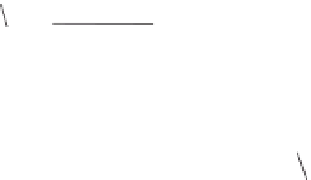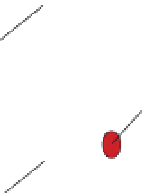Geology Reference
In-Depth Information
Terranes and micro-plates:
compound orogenic belts
Only the simplest orogenic belts consist
of two continental plates separated
by a single suture zone. Many, on the
other hand, are made up of several
distinct pieces of continental crust
that have become welded together,
each separated from its neighbour
by a
suture zone
. Figure 10.5 shows
one such example, where two plates
enclose a smaller piece of crust that
could be referred to as a
micro-plate
.
Geologists working in the northern
American Cordillera have distinguished
a number of such crustal units there,
referring to them as
terranes
. They
have developed several geological
criteria for distinguishing terranes:
they must exhibit a different structural
history from neighbouring regions
and ideally contain palaeomagnetic
or fossil evidence of derivation from
some distance away from their neigh-
bours. In the North American case,
some of these terranes represent pieces
of crust that have broken away from
another continent and migrated across
the ancestral Pacific Ocean to collide
with the North American plate once
the intervening oceanic lithosphere
has been subducted. Such a collision is
known as a
docking
event. Other ter-
ranes have been moved to their present
positions along major transform faults.
Terranes are now widely recognised
as an important constituent of many
orogenic belts; they are of three main
types: continental micro-plates that
have separated from another conti-
nent; volcanic island arcs; and pieces of
unusually thick oceanic crust known as
oceanic plateaux
. The process of
back-
arc spreading
, discussed in Chapter 3
micro-
plate B
Figure 10.5
Terrane amalgamation.
Cartoon showing how a compound
orogenic belt composed of more
than two colliding plates (cross-
section 3) can be understood in
terms of the sequence of collisions
of its constituent parts. Thus in
cross-section 1, two continental
plates A and C are about to collide
with an intervening volcanic arc (or
micro-plate) B; in (2), plate A has
collided with micro-plate B, while
B is still subducting beneath C; in
(3), the combined plates A and B
have now collided with C to form
a compound orogen consisting of
three terranes. The sequence of
docking of the terranes is revealed
by comparing the age of the post-
collision pluton P1 with that of the
younger post-collision pluton P2.
volcanic
island
arc
back-arc
basin
continental
plate A
continental
plate C
10
oceanic
plate
84
85
1
micro-
plate B
volcanic
arc
orogen
plate A
plate C
post-collision
pluton
2
post-collision
pluton P2
micro-
plate B
orogen
plate C
plate A
post-collision
pluton P1
3
(
see
Figure 3.11) is an important source
of micro-plates. This seems to occur
when the upper plate and the trench
are moving away from each other. The
resulting extensional stress causes thin-
ning of the continental lithosphere, and
ultimately the creation of new oceanic
lithosphere behind the volcanic arc.
Compound orogenic belts consist-
ing of several amalgamated terranes,
which may have docked with the main
plate at different times, inevitably
display a more complex geometry and
tectonic history than one formed by
a single collision event (Figure 10.5).
Each separate collision will involve a
subduction process followed by a col-
lision event, both with their accompa-
nying structures, and it is necessary to
use careful analysis and sophisticated
dating methods to separate them. In
Figure 10.5, the sequence of docking
is revealed by comparing the dates of
the two post-collisional plutons P1 and
P2: since P1 is older than P2, plate A
must have docked with micro-plate B
before the latter docked with plate C.
Oblique convergence
There are few presently active orogenic
belts where the convergence direction
is exactly perpendicular to the trend
of the belt. A glance back at the plate
movement vectors in Figure 3.7 shows
that in many cases the convergence
direction across the plate boundary is
highly oblique: see, for example, the
Pacific-North American boundary and
the northern Indonesian sector of the
Indian-Asian boundary. It is usually
easier for structures to form parallel to
major pre-existing crustal features, such
as the continental margin itself. There-
fore, oblique convergence has the result
of dividing the oblique compressional
stress across the boundary into two sets:
one set, acting at right angles to the
boundary, producing folds and thrusts
that trend parallel to it, and a second
set, acting parallel to the boundary,
























































Search WWH ::

Custom Search